This paper was presented
at the 2009
CESNUR Conference. It appears in the book from The Dawn Horse
Press, The
Rebirth of Sacred Art, along with Adi Da's essay, "The
Maze of Ecstasy".

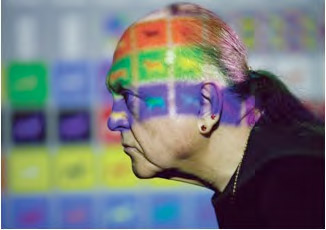
Introduction
For nearly forty years the artist, scholar and spiritual teacher
Adi Da Samraj (born 1939) has been involved in the production
of a highly diverse and unique body of artistic work, ranging
from Zen-like ink brush paintings to photography, videography
and, most recently, monumentally scaled abstract geometric images
generated by digital technology.1
Adi Da’s purpose in all of this work was to create images which
would enable the fully participatory viewer to experience a taste
of the inherently blissful state of nondual awareness that he
asserts is our native condition once we transcend the presumption
and experience of being a separate “subjective” self perceiving
a separate “objective” reality. To make such “aesthetic ecstasy”
possible he formed each image to be a “Self Presentation of ‘Reality
Itself’,”2 which he describes
as being inherently “Non-separate, One and Indivisible,”3
and always prior to space-time and every separate and separative
“point of view.”
Adi Da’s exploration of the art of “Reality Itself” culminated
in his abstract geometric images which he describes as being “aperspectival,
anegoic and aniconic.” Whereas his work with the camera “established
an approach to image-making which transcended the inherent limitations
(or fixed characteristics of the camera as a ‘point of view’-machine”,
these monumentally scaled geometric images were aimed at undermining
“the structuring-force of the conventional and ego-based uses
of the body as a perceptual mechanism.”4
His purpose in doing this was to liberate the image-making as
well as the image-perceiving process into “the free-domain of
egoless coincidence with Reality Itself’.”5
Adi Da’s collateral exhibition at the 52nd Biennale di
Venezia in 2007, curated by renowned art critic, Achille Bonito
Oliva, marked the first time his visual art was shown to an international
art public.6 During the spring
of 2008 selections from that exhibition are once again on view
at the exhibit, Transcendental
Realism: The Art of Adi Da Samraj, displayed in the Cenacolo
di Ognissanti in Florence, Italy. The spatial juxtaposition in
the same room of Adi Da’s monumental aperspectival geometric
art with Domenico Ghirlandaio’s large perspectival fresco
of The Last Supper, provides an occasion for considering
the nature, meaning and experience of Adi Da’s work within
the framework of the history of Western consciousness, culture
and art.
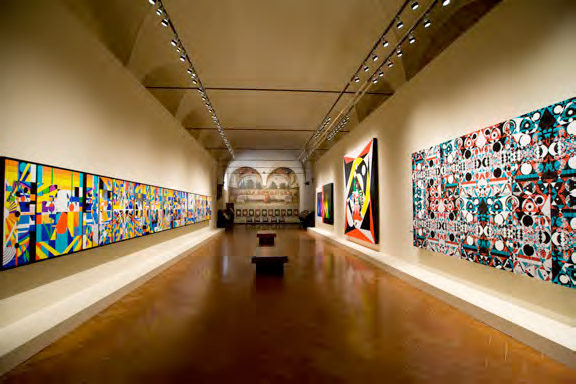
The Invention and Importance of Linear Geometric Perspective
In the history of Western civilization, it is generally recognized
that the shift from the Medieval Age to the Renaissance marks
the transition from a God-centered society to a human-centered
society. This great transformation in consciousness and culture
arose first in the realm of art, and is marked by the discovery
of linear geometric perspective by the Florentine architect Filippo
Brunelleschi (1377-1446) at the beginning of the fifteenth century.7
This invention then spread throughout the western world when the
rules for perspective were codified by artist, architect and philosopher
Leon Battista Alberti (1404-1472) in his widely influential book,
Della pittura, which was published in 1435.8
Perspective revolutionized art and architecture, and even culture
altogether, in the Western world for the next five hundred years,
contributing to the rise of Cartesian science, Enlightenment Reason
and the modern culture of secular humanism. Thus, it would not
be too much of an exaggeration to say that the world we live in
today largely finds its origins in ideas, perceptions and practices
that grew out of the artistic culture of the city of Florence
some six hundred years ago.9
The story of Brunelleschi’s dramatic public demonstration
of the power of perspective reveals a great deal about the spiritual
origins and nature of the modern world. Sometime around 1425,
Brunelleschi secretly painted a small, highly realistic image
of the Baptistery of San Giovanni as it would have appeared in
a mirror-reversed perspective when seen from a single point of
view located just inside the portal of Santa Maria del Fiore,
the great Duomo opposite the Baptistery for which he was later
to build the world’s largest dome. This painting also included
as much of the piazza and the surrounding buildings as would have
been visible from a cone of vision located at that single point.
Instead of painting a sky, however, he burnished the area where
the sky would have been with silver so that the actual sky could
be reflected in it. For purposes of his demonstration, Brunelleschi
also drilled a small hole in the painting of the Baptistery at
the point that would have been exactly opposite the point within
the portal of the Duomo from which the perspective of the Baptistery
had been constructed.

Brunelleschi then set up his painting between the Baptistery
and the entry to Santa Maria del Fiore, and called for volunteers
to look through the peephole from behind the surface of the painting
with one eye, while holding a mirror at a mathematically correct
distance in front of the painting. Astonishingly to all who were
gathered, each viewer saw what appeared to be the actual scene
of the Baptistery and Piazza of San Giovanni as it would have
appeared had they been standing and looking at it from the portal
of the Duomo. The effect of the mirror was to minimize the viewer’s
awareness of the presence of the painted surface and to intensify
the sense of depth of the painting. Also, because of the silvered
sky in the painting the mirror reflected the real sky with its
constantly moving clouds within the sky of the painting, imparting
a heightened and even magical sense of reality to the painted
image.10 When viewers lowered
the mirror, while still looking through the peephole, they were
astonished to see what appeared to be the same view of the Baptistery
that they had seen through the reflected mirror image of Brunelleschi’s
perspectival painting.
By thus demonstrating to the public the breathtaking realism
of his newly discovered system of linear geometric perspective,
it seemed to Brunelleschi’s contemporaries that he had discovered
how to re-create the world through the power of an art that precisely
reflected physical reality as it is seen by the detached observer.
Alberti even described Brunelleschi as a second god in
his dedication to him in the Italian edition of his book, in which
he presented a systematic explanation of Brunelleschi’s
perspective system for use by artists and architects.
As seen by Alberti and others during the time of the Italian
Renaissance, the magical new art of perspective not only had the
power to turn the artist into a god-like being capable of replacing
reality with life-like simulacra but seemed itself to possess
a divine force by which mortality and the terror of time could
be overcome. Not only could paintings make their subjects appear
to be present when they were physically absent, but they could
also confer a kind of immortality through the power of the image
to live on unchanged by the passage of time. By thus freezing
space and time in a single moment from a single point of view,
(as the camera would someday do even more convincingly), linear
perspective granted the artist an illusion of power over the mortal
realm and promised a kind of deliverance from the fear of death
that accompanied the rise of individualism at the beginning of
the modern age.11
Rather than seeing perspectival painting as being opposed to
Christian teachings about the nature of God and cosmos, as St.
Augustine might have imagined had he lived to see this radically
new form of art, Alberti and other highly religious Renaissance
artists such as Domenico Ghirlandaio (1449-1494), believed that
linear perspective would allow art to replace magic in the service
of religion.12 While the
many extraordinarily beautiful religious paintings done in this
style of spatial and material realism did initially have the intended
effect of intensifying religious fervor, the very use of perspective
and realistic rendering techniques over the centuries also had
the entirely unintended effect of helping to undermine the grand
edifice of the God-centered, dualistic medieval worldview which
still dominated thought and belief at the time of the Renaissance.13
Renaissance Perspectival Art and the Aperspectival Art
of Adi Da Samraj
In addition to codifying and communicating rules for the construction
of linear geometric perspective, Alberti further asserted in his
book that the inventor of the quasi-divine art of painting itself
was none other than Narcissus. In Ovid’s tale, Narcissus
is the beautiful and beloved child of the gods, who refused the
love of Echo and died alone gazing in the pond, transfixed by
his mirrored image and longing only to embrace his own reflection.
Alberti, the great theorist of the art of perspective in painting,
thus openly, if perhaps unintentionally, portrays painting as
a form of self-love and self-deception, a turning away from love
and all relationships in order to possess a reflected self-image.
Without apology Alberti was thus acknowledging the Narcissistic
roots of visual art and the modern age.14
What is of particular interest in a consideration of the aperspectival
art of Adi Da Samraj in this account of the origins of visual
art and the birth of perspective in Renaissance Italy, is the
fact that for nearly four decades Adi Da has used the image of
Narcissus as a primary metaphor to describe what he calls the
“ego-‘I’,” or, the “separate and
separative self.”15
Rather than creating an art that celebrates and reinforces Narcissus’s
fixation on his own image as it is reflected in the pond, as Alberti
and other Renaissance artists did, Adi Da has dedicated his art
to drawing the attention of Narcissus away from the pond. As he
has repeatedly pointed out, linear geometric perspective was (and
is) the defining art of the ego-“I”: it is a way of
both picturing and reinforcing our human bondage to a single,
limited and entirely conditional point of view. “In the
conventions of perspectival image-art, the physical eye and the
ego-'I' are the same.”16
By contrast, Adi Da explains that, “The intrinsically ego-transcending
root-presumption associated with the image-art I make and do is
precisely the opposite of the ego-based and ego-idealizing root-presumption
associated with perspectival image-art. Perspectival image-art
glorifies the ego’s construction of the world — as
if that ego-constructed world is (itself) Reality Itself —
whereas Reality Itself is always prior to the ego’s construction
of a world and to any and every 'point of view' within the world.”17
Properly understood, then, Adi Da’s aperspectival images
must be seen and experienced as a literal inversion of the logic
and method of Narcissus and a radical response to the limitations
implicit in perspectival vision that have dominated the last six
hundred years of Western art, architecture, science and religion.
The Modernist Revolt Against Perspectival Consciousness
and Vision
In a complex and often paradoxical process that began with the
invention of perspective in the Renaissance, the ego-centered
and materialistic development of Western civilization progressed
unchallenged for hundreds of years, following the inexorable logic
of its own premises and methods. Then, suddenly and unexpectedly
at the beginning of the 20th century, all the arts and sciences
exploded in what can only be described as a widespread rebellion
in the western world against the limitations of perspectival thought,
perception and expression.18
As a result, all prior understandings of the nature of space,
time and reality in the domains of art and science were forever
changed, with consequences that are only now beginning to be realized.19
In 1905 Albert Einstein read his momentous paper on electrodynamics,
concluding that no particular observer or point of view was more
privileged than any other within the framework of universal space-time.
Arnold Schoenberg challenged the continuity of the western classical
musical tradition with the development of twelve-tone (or serial)
composition. Braque and Picasso broke with the tradition of perspectival
representation that started with the Renaissance, producing Cubist
paintings that portrayed objects from multiple perspectives simultaneously,
suggesting, in still another way, the relativity of all points-of-view.
Other artists, including Wassily Kandinsky, Robert Delaunay, Kasimir
Malevich, and Piet Mondrian, began to free themselves of all attempts
to represent objects as they appear in the physical world and
moved in the direction of a completely new abstract art.20
In 1922, James Joyce summarily overturned the linear, sequential
narrative tradition of the novel with the publishing of his book,
Ulysses. Ludwig Mies van der Rohe, Le Corbusier and Walter
Gropius designed buildings with non-load-bearing walls, fluid
spaces with dynamically shifting perspectives and transparent
building skins emphasizing the interconnections between inside
and outside. And, with the design of his first Taliesin complex,
his home and studio in Spring Green, Wisconsin, Frank Lloyd Wright
was bringing to maturity a historically unprecedented organic
architecture that he believed would finally destroy “the
box”, illuminate the “cave of human dwelling,”
and join architecture and nature in a new symbiotic unity.21
Adi Da points out, however, that this Modernist revolt against
perspectival consciousness was occurring within the context of
two catastrophic world wars and a planetary process of civilizational
collapse, rather than within a framework that allowed for the
possibility of cultural renewal.22
Thus, rather than continuing to explore the liberating impulses
of modernism, the last decades of the twentieth century saw the
emergence of what has been called postmodernism,
which in spite of some of its positive aspects, largely has devolved
into a solipsistic, ironic and radically relativistic worldview
which both expresses and gives rise to a spreading sense of nihilism
and despair.23
As a result we now find ourselves living in a world in which
there are no longer any master narratives or privileged “points
of view” from which to understand or describe the irreducibly
complex and ultimately mysterious reality in which we find ourselves.24
It is as if the culturally sanctioned world that has been in the
making since the Renaissance has reached its reductio ad absurdum
and is now in the process of deconstructing as both a desirable
and viable cultural form and mode of consciousness.25
Thus, at the beginning of the twenty-first century it seems that
all things are possible, everything is relative, and nothing has
any intrinsic meaning.26
At the end of our centuries-long quest for individual freedom,
material comfort, scientific certainty and technological control
over nature, we have arrived at a condition in which all certainties,
authorities and traditions are dissolving into a morass of irreducible
relativity, with everything from the planetary ecology to the
global economy spinning out of control. Reality not only seems
to elude our grasp, but, in principle, seems to be ungraspable.
It is within the context of this long historical process leading
to our present environmental, existential and societal crises
that Adi Da’s aperspectival geometric art must be understood.
He summarizes our moment in time, as it relates to the purposes
of his art, clearly and succinctly: “The old civilization
idealized the ego, and it ended up with a world of egos destroying
one another. That course, in fact, is still happening and must
be stopped — but it cannot be stopped merely by force. A
transformation of human understanding and of human processes altogether
must occur — on every level, including the artistic level.”27
While noting the importance of their prescient spiritual intuitions
and important artistic accomplishments, Adi Da also observes that
the avant garde artists of the early twentieth century never fully
succeeded in transcending “point of view”: ironically,
they ended up preserving “point of view” by merely
asserting the simultaneous presence of multiple points of view.
In making his art, Adi Da’s intention is to fully realize
what was only implicitly potential in the Modernist project: complete
liberation from “point of view” itself.28
He describes his image-art in these terms: “The image-art
I make and do is the intrinsically ego-transcending — and,
thus and thereby, perspective-transcending, or intrinsically aperspectival
— image-art that participates in (or egolessly coincides
with) Reality Itself.”29
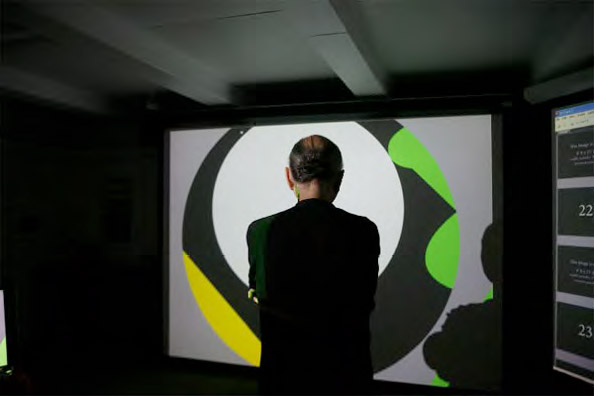
If the perspectival art of the Renaissance helped to initiate
a spiraling trajectory of societal changes which eventually led
to the modern and postmodern worlds, then, as Adi Da asserts,
a truly “aperspectival, anegoic and aniconic” art
is required for the creation of the new modes of perception and
understanding necessary for the next great transformation in consciousness
and culture.30 As he says,
his purpose is to contribute to just such an epochal change, “I
am making art that is intended to be of greatest significance
and transformative power — art that invites profound participation,
rather than the mode of casual and dissociated viewing that allows
and supports (and even requires, and, ultimately, even institutionalizes)
mere ‘objectification’ and dissociative (or strategically
non-participatory) detachment. I want to transform people's participation
in art — and also their participation in Reality (Itself,
and altogether) — and help them to a new way of life, out
of the “dark” period in which humankind is presently
immersed.”31
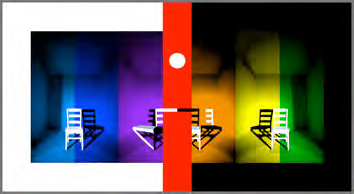
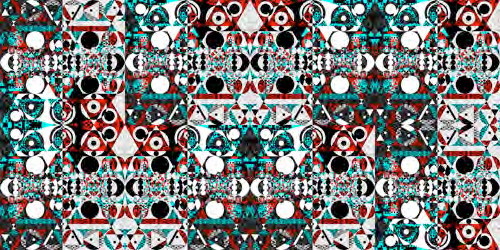
Transcendental Realism: The Art of Adi Da Samraj
The spring 2008 exhibition in Florence, Transcendental
Realism: The Art of Adi Da Samraj, offers visitors an
opportunity to experience four selections of Adi Da’s recent
aperspectival art displayed in the Cenacolo di Ognissanti, a beautiful
space which contains one of the finest examples of the perspectival
art of the Renaissance, The Last Supper (1480), a fresco
by Domenico Ghirlandaio. Thus, at this exhibition it is possible,
within the confines of a single room, to experience two radically
different visions of art, consciousness, and reality which have
arisen out of two very different historical epochs. It might be
said that at this exhibition one is able to look back to the glorious
art of the past and forward toward the unknown vistas of the art
of the future.
Adi Da provides a tri-partite framework that is essential for
understanding his art in relation to the art of the past. He says
that “There is ‘God-art’, there is ‘ego-art’,
and there is ‘Reality-art’.”32
In the context of this framework, he considers pre-Renaissance
art in the west to be “God-art”, a form of expression
that is “about what the space-time-bound ego presumes to
exist above and beyond itself.”33
The content of such art, in his view, is “principally intended
to visually portray the mythology of divinity in one mode or another,
including (in later centuries) the Christian mode.”34
Since it was presumed that the realm of God, or the gods and various
mythological beings, was fundamentally immaterial, spiritual and
transcendental there was no desire before the Renaissance to visually
represent “God-space” as being anything like the physical
spaces of the everyday world. “God-art” was thus conceived
as being entirely symbolic rather than “realistic”.35
The Renaissance represented a radical break with this ancient,
universal tradition of sacred art. For the first time artists
became passionately interested in making geometrically accurate
representations of physical spaces and the material objects within
them. Even religious art was increasingly valued for how well
it simulated the physical world rather than by how well it evoked
a vision of an intrinsically unknowable and mysterious spiritual
world: from the Renaissance onward the inner eye of the spirit
was gradually replaced by the physical eye of the body as the
primary organ of perception and knowledge.36
As a result, according to Adi Da, western art since the Renaissance
can be described as “ego-art”, which is art that is
“specifically designed to portray the ego’s view (or
‘point-of-view’-construction) of ‘reality’,
by means of the systematic application of the codified laws of
perspective.”37 He
goes on to say that, however, that, “Even the thoroughly
secularized avant-garde Western image-art of the ‘modern’
and ‘post-modern’ era is still a play upon (or a failed
effort to escape from) the tradition of ‘ego-art’,
or ‘point-of-view’-art.” Thus we are still living
within the era of “ego-art”.38
Ghirlandaio’s Fresco of The Last
Supper
Ghirlandaio’s beautiful and masterfully executed fresco
of The Last Supper fills the short end of the long narrow
refectory at the Ognissanti church, While its content is still
religious in nature, it is a paradigmatic example of what Adi
Da calls perspectival “ego-art”. Painted as an illusionistic
extension of the actual space of the room, this softly colored
and balanced image presents the traditional scene of Jesus and
the apostles gathered around a table partaking of Christianity’s
first sacramental meal. It is rendered in the same style and in
the same colors as the room itself. The arches of the ceiling
of the painting follow the lines of the actual space while the
floor of the painted room is placed above the floor of the refectory,
creating the impression that one is looking at a kind of raised
niche or alcove. The human figures and material objects in the
fresco are realistically represented as three-dimensional physical
bodies, receiving light from their painted windows and casting
the appropriate shadows. Beyond the arches of this painted room
one can see realistically rendered but highly symbolic trees,
birds and a calm, cloud-filled sky. One has the sense of looking
beyond the real room and through the virtual space of the fresco
into a “real” outside world, which extends infinitely
beyond one’s sight.39
The effect of Ghirlandaio’s perspectival illusion is to
create the impression that the figures in the Gospel story are
actually present in the same space in which the viewer is located.
By means of perspective and realistic forms of material representation,
the barriers between real space and virtual space, sacred space
and profane space, times past and times present are magically
dissolved to create a new unified spatio-temporal reality. Ghirlandaio’s
fresco is a visually pleasing and comforting work of art that
makes few demands on the viewer. For today’s visitors it
readily affirms the way we have learned to see the world since
the Renaissance. To the viewers in the fifteenth century, however,
it must have figured a dramatically new sense of reality which,
as intended, strongly reinforced the Church’s Medieval Christian
worldview.
Looking at Ghirlandaio’s fresco, one can readily see that
the surface of perspectival art such as this is, just as Alberti
said, a kind of window, an invisible picture plane which looks
onto a purportedly “objective” outside world. The
space beyond this window, however, does not include the viewer,
who always remains detached, floating somewhere outside the picture.
If one is attentive to the actual experience of The Last Supper,
it is also possible to feel how one’s ordinary, taken for
granted sense of being a separate skin-bound self existing within
an objective, all-surrounding outside world (not-self) is magnified
by means of perspective. As Adi Da observes, this reinforcement
through art of “point of view” consciousness comes
with a hidden cost. “When one looks at perspectivally-based
image-art, one is constantly being reminded of oneself, constantly
being relocated in one’s own presumed separateness. One
is, in effect, constantly walking into one’s own face. Thus,
perspectivally-based image-art is inherently Narcissistic art,
regardless of its apparent ‘subject’ matter.”40
Adi Da’s Alberti’s
Window I
Adi Da’s aperspectival art is radically different from
all forms of myth-based “God-art”, as well as all
forms of perspective-based “ego-art”, and even all
forms of non-perspectival and multi-perspectival “ego-art”
of the modern and post-modern eras. He defines the images he makes
as an entirely new kind of artistic expression. “The image-art
I make and do is ‘Reality-art’--not in the conventional
sense of image-art that imitates or merely reproduces ordinary
‘reality’…but in the sense of image-art that
intrinsically egolessly coincides with Reality Itself.”41
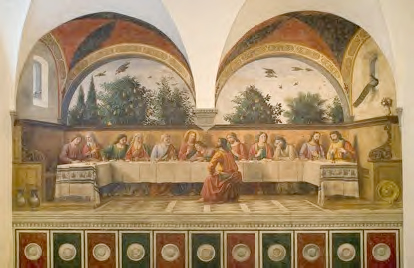
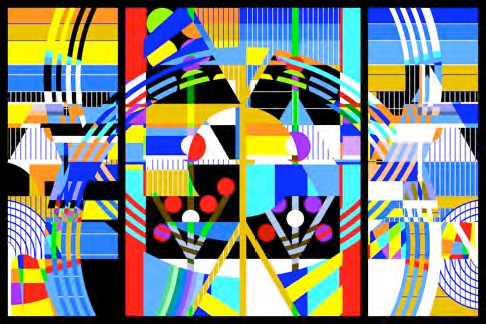

By intention, then, both the design and experience of Adi Da’s
aperspectival images are radically different from perspectival
images such as Ghirlandaio’s fresco, a fact which is powerfully
evident in Alberti’s Window I (2006-7), the largest
(137 x 1,419 cm) example of Adi Da’s recent geometric art
to be included in the exhibition. He explains: “I have given
the title ‘Alberti’s Window’ to the suite Geome
One as a means of pointing out that the image-art I make
and do is, in fact, not Alberti’s kind of space,
not the traditional space of Western art — which
(first) 'objectifies' the surface of the artwork, and (then) uses
various devices to draw the 'viewer' into the 'objectified' surface.”42
To fully understand and experience this monumental work of art
as intended, the viewer must first un-learn his or her prior understandings
of the nature and purpose of art as well as his or her socially
conditioned habits of art viewing.43
At first glance, for example, one might be tempted to not really
“see” Alberti’s Window I, preferring
simply to breeze by it, casually noting how it can be placed in
its proper art historical category. Indeed, it is possible to
observe formal resemblances between this image and similar works
of a number of the masters of abstract modern art. But to see
this, or any other work by Adi Da Samraj, merely as an exemplar
of a type of art produced in the past would be to miss the life-changing
experience he intends his viewer to have.44
Alberti’s Window I, like all of the other image-art
he has created over a period of some forty years,45
is not merely a meaningless play of abstract forms and colors
on a two dimensional surface.46
Rather, it is a complex, paradoxical play between abstract form
and fundamental meaning intended to create a vehicle for an ego-forgetting
and ego-transcending aesthetic experience.47
Adi Da began the piece called Alberti’s Window I
by making photographs of the environment in which he lives, including
views looking out of a window in his studio in Fiji. Using these
images “as a visual starting point — like a sketchbook,
and a key to unlock feeling memory”,48
he proceeded to make computer-generated images in response to
the image-content of his photographic “sketches”.49
By means of a spontaneous response to each iteration of the developing
image itself, he created over time an aperspectival work of art
radically different from the visual world of Ghirlandaio’s
fresco. Thus, as he explains, “The imagery in Alberti’s
Window does not follow the 'rules' of perspective, nor does
it presume the usual 'subject-object' orientation, as if actually
looking through a window to 'outside'. In Alberti’s
Window, the surface itself is the domain of the event that
is the image.”50
While meaning is maintained, in part, by Adi Da’s constant
reference to the original photographs taken at the beginning of
the process, the forms and colors of Alberti’s Window
I also embody the fundamental principles of what Adi Da calls
“Reality Itself”, which, according to him, is what
the world is before it is perceived by any “point of view”
of any self-contracting ego-“I”. While it is clear
why and how linear perspective makes use of geometry to create
its spatio-temporal illusions, it is not so readily apparent why
or how Adi Da Samraj uses geometry to create order and meaning
in his art.
Noting with approval that Cezanne, and various artists since
Cezanne’s time, have created art based on the use of primary
geometries, Adi Da observes that, when fully and deeply experienced,
the structure of human perception and the structure of the manifest
world itself are both rooted in the underlying presence and ceaseless
play of primary forces and geometries.51
He uses geometry as his primary means of artistic expression in
Alberti’s Window I, and his other aperspectival
geometric art, because he believes that this abstract formal language
speaks wordlessly and universally to the underlying order of both
self and world.52 Thus, because
Alberti’s Window I is built out of the interplay
of primary geometries, it is possible to tacitly feel, when standing
in the presence of this monumental work, that one is perceiving
a meaningful field of generative forces rather than a meaningless
display of geometric forms.53
One experiences in the geometric structure of this work the essence,
rather than merely the outcome, of nature’s processes of
being and becoming.
But what of Adi Da’s use of strong, radiant, and light-filled
color in Alberti’s Window I? Starting with his
Spectra Suites in 2006, Adi Da has used a palette of
“pure” colors in order to orchestrate very specific
effects: “A pure color is a vibration…a piece of
the spectrum of visible light…Color is not arbitrary. It
must be exactly right for each image in particular. Color has
emotional force.54 Colors
in relation to one another generate, by that relatedness, different
modes, or tones, of emotional force.” He further explains
that, like primary geometry, color also “has meaning in
the nervous system, in the folds of the brain. That meaning is
not something that can altogether be stated verbally, but meaning
is inherent in color.”55
Thus, depending on the subject, each work of art he does requires
its own palette of colors.
Alberti’s Window I is constructed out of a full
spectrum of pure and vibrant colors, which, like the crisp, precisely
delineated geometries characteristic of the piece, are made possible
by the use of digital technology and advanced methods of image
fabrication.56 Color values
range from light to dark, and include hues ranging from cool tones
at one end of the rainbow to warm ones at the other. Each color
strikes a different note, giving rise to overtones and undertones
of feeling-response and meaning-association. One finds, for example,
dark shades of cobalt blue as well as airy tones of light-infused
powder blue, in the cool end of the spectrum, that evoke feeling-images
of ocean depths and endless skies. Robust, full-bodied hues of
warm orange, various shades of golden yellow and intense, otherworldly
reds trigger feeling-memories of spreading sunsets, the glowing
radiance of evening fires, and the rich earthy tones of soil and
rock. Woven amidst this complex field of geometrically structured,
multi-layered and interacting colors, one also finds pure black
and pure white.
Thus, even though one cannot literally see painted images of
the primal elements of earth, air, fire and water, one can feel
their presence. While Alberti’s Window I is not
representational, as in the case of such “realistic”
paintings as The Last Supper, it does express at an archetypal
level the all-pervading presence of the primal elements and shaping
forces which are always at play in the constantly changing, self-regulating
and dynamically balanced natural world.
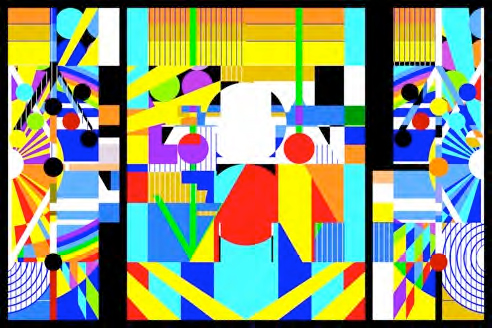


But, remarkable as this accomplishment might be for any abstract
geometric work of art, Adi Da, it will be remembered, claims much
more for his images than the mere depiction of the deep structures
and archetypal experiential qualities of cosmic nature. “My
image-art is made and done to perceptually embody — and,
thus, by means of the ‘aesthetic experience’, to communicate
— the inherently egoless, non-separate, and indivisible
Self-Nature, Self-Condition, Self-State, and Perfectly Subjective
'Space' That Is Reality Itself.”57
Such a bold intention would suppose, at the very least, that
the perceptible visual patterns, colors and subtle qualities of
images such as Alberti’s Window I would be homologous
to what he claims is the very nature and structure of “Reality
Itself”. While words must always fail to describe that which
cannot be said, Adi Da does indicate that “Reality Itself”,
or “That Which Is Always Already the Case” has, “no
‘thing’ in it, no ‘other’ in it, no separate
‘self’ in it, no ideas, no constructs in mind or perception,
and, altogether, no ‘point of view’.”58
Does Adi Da’s art measure up to this standard? Does Alberti’s
Window I communicate a sense of non-separateness and the
“irreducible paradox of unobservability and unknowability”
that he claims is the “actual (Real) state of every one
and every thing — even in the apparent context of all things
arising.”59
When first gazing upon Alberti’s Window I, the
mind and the mind’s eye race to discover the hidden order
that structures and, therefore, explains the power and beauty
of the work. One wants to get a handle on it, figure it out, domesticate
its strangeness, reduce its complexity to something simpler, something
that can be named and known. And at first, it seems that it might
be possible to do so. Yes, there are indeed organizing structures
to be observed. First of all, one notices that the great length
of the piece is divided into seven identically sized triptychs,
each of which has a larger central panel and two smaller side
panels. The central triptych, which has two large multi-colored
circles intersecting to create a large eye-like vesica piscis,
appears at first glance to give the work a kind of overall symmetry.
Yet, a closer look reveals that there is, in fact, no overall
symmetry: the images to the left of the central triptych are more
complex and less clearly ordered than the panels on the right
of it, which are calmer, less brightly colored, more highly ordered
and more figural. Thus, while each individual triptych might remind
one of the daily movement of the sun from morning to night, the
temporal rhythm of the overall piece is directional as one moves
from left to right, rising to a peak of balanced harmony in the
center and falling back to a state of subdued calm and greater
formal simplicity at the end. One senses in this pattern the presence
of both circular time and linear time. With this insight, the
thinking, grasping mind has something else to say about this enormous
image, something else to hold on to.
Other formal ordering devices also can be noted and described.
There are, for example, both horizontal and vertical regulating
lines, which define fields and sub-fields where changes in geometry
and color tend to occur. Certain form motifs repeat to give an
overall sense of unity: radial patterns originating in central
white circles dance across the length of the piece; fields of
vertical stripes, containing multiple figure-ground color reversals
unify the image in the vertical dimension; triangular forms and
linear arrow-like motifs keep showing up, creating a sense of
rising and falling forces; strongly colored red, yellow, white
and blue circles of various sizes emerge as recurring figural
forms, appearing at first to be clearly separate elements, only
later to be seen as circular windows opening views into underlying,
layered fields of color, which recede or advance according to
the laws of color perspective.

Second panel, Alberti’s Window I
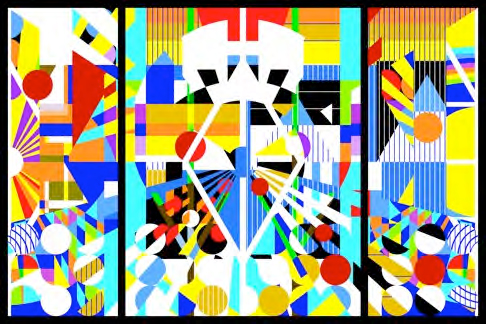
Sixth panel, Alberti’s Window I

Alberti’s Window I
The longer one spends with Alberti’s Window I,
however, the more it becomes evident that every apparent ordering
system is always also inevitably undermined. Exceptions to the
rule are the rule. Every instance of local order arises only to
dissolve again into a playfully creative chaos, which is a paradoxical
kind of order that can be felt but never fully described. Eventually,
one comes to the conclusion that in Alberti’s Window
I there is order without system, in a work of art that is
a living field of dynamically balanced polarities. Symmetry and
asymmetry, cool colors and warm colors, horizontal lines and vertical
lines, rising forces and falling forces, circular forms and angular
forms, advancing colors and retreating colors, pure geometries
and undefinable shapes are woven together to create an image that
is never at rest, yet, always seems to be calm and centered. One
slowly comes to the understanding that in Alberti’s
Window I there are, indeed, no separate forms, and that a
mysterious sense of creative order and a prior, underlying unity
are all-pervading.
Finally, when the compulsive search for order, purpose and meaning
falls completely away, and one simply becomes mindless in the
face of the overwhelming size, seductive beauty and incomprehensible
complexity of this monumental work of art, one discovers that
Alberti’s Window I cannot be defined or grasped
by the mind’s eye or the ego’s “I”. The
only possible response that is left is to surrender, simply and
spontaneously to the allure of the piece and to wander happily
without any “point of view” in the dimensionless spaces
of this primal landscape, which is a reality that is both familiar
and strange. Forms are then felt with the “eyes of the skin”,60
colors are sensed as temperatures and qualities of being, and
order is experienced as what Adi Da describes as a “non-necessary”
and “non-binding” appearance arising out of an unseen
reality both infinite and filled with light. In this realm and
state, there is no time and there is no space. This experience
brings a sense of freedom that is unthreatened and unthreatening.
There is only pleasure and delight that spontaneously and naturally
arises as soon as the frenzy of seeking and the need to name and
control is forgotten. This is the experience that Adi Da describes
as “aesthetic ecstasy”, which is his true purpose
in creating his art:
|
The living body inherently wants to Realize (or Be
One With) the Matrix of life. The living body always
wants (with wanting need) to allow the Light of Perfect
Reality into the “room”. Assisting human beings
to fulfill that impulse is what I would do by
every act of image-art. My images are created to be a means
for any and every perceiving, feeling, and fully participating
viewer to “Locate” Fundamental and Really Perfect
Light — the world As Light, conditional (or
naturally perceived) light As Absolute Light. Ultimately,
when "point of view" is transcended, there is
no longer any "room" or (any separate "location"
and separate "self") at all — but only Love- Bliss-"Brightness",
limitlessly felt, in vast unpatterned Joy.61
|
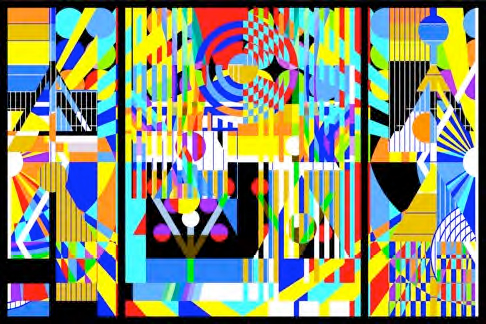
Third panel, Alberti’s Window I
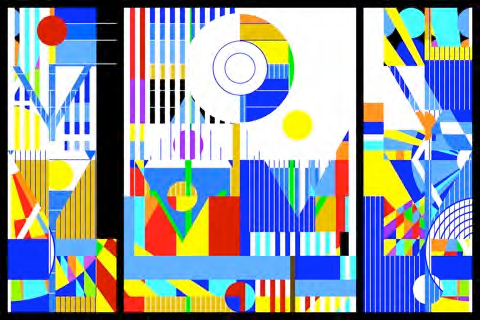
Fifth panel, Alberti’s Window I

Alberti’s Window I
Wassily Kandinsky wrote in 1910-11 that, “The great epoch
of the Spiritual which is already beginning…provides and
will provide the soil in which a kind of monumental work of art
must come to fruition.”62
Were he alive today, Kandinsky might well consider the monumental
art of Adi Da Samraj to be the fulfillment of the spiritual-artistic
impulse that he and other revolutionary artists at the beginning
of the twentieth century sought to bring into the world through
the invention of abstract art. If properly understood and rightly
and fully experienced, the aperspectival geometric art of Adi
Da Samraj can be seen as a harbinger of a new age of consciousness
and culture.
|
|
|
“I Am Manifesting the self-organizing force of Reality
in the context of perception and communication—and, therefore,
of images.”
Adi Da Samraj
|
Return to "What Others Say About Adi Da's Art"
 FOOTNOTES
FOOTNOTES

1 For an excellent overview
of the visual art of Adi Da Samraj, see Mei-Ling Israel, The
World as Light: An Introduction to the Art of Adi Da Samraj,
Middletown, CA: The Dawn Horse Press, 2007. Some of Adi Da’s
early photographic works can be seen in Adi Da Samraj, The
Bright Field: The Photographic Art of Adi Da Samraj, Middletown,
CA: The Dawn Horse Press, 2001. A selection of monumentally sized
multiple-exposure images taken underwater can be seen in the exhibition
catalogue, Adi
Da Samraj, The Quandra Loka Suite: 52 Views (The Indivisible Space
of Conscious Light), Louis Stern Fine Arts, 2003. This
beautifully produced volume also includes an illuminating essay
on Adi Da’s photographic art by noted critic Donald Kuspit.
Adi Da’s large format book, The
Spectra Suites, Welcome Press, 2007, presents works that
integrate digitally generated images with those he has produced
using still and video cameras. Donald Kuspit once again provides
an incisive essay in this volume.
2 Adi Da Samraj, Transcendental
Realism: The Image-Art of egoless Coincidence With Reality Itself,
Middletown, CA: The Dawn Horse Press, 2007, pg 34.
3 Adi Da Samraj, Perfect
Philosophy: The “Radical” Way of No-Ideas, Middletown,
CA: The Dawn Horse Press, 2007, pg 40.
4 Adi Da Samraj, “The
Final Resolution of Geome, Linead, and Orphic Font”, unpublished
essay, November 25, 2008.
5 Ibid.
6 See the Venice Biennale
exhibition catalogue, Transcendental Realism: The Art of Adi
Da Samraj, Middletown, CA: The Dawn Horse Press, 2007. (With
essays by Achille Bonito Oliva and exhibition Co-Curator Peter
Frank as well as an artist’s statement by Adi Da Samraj).
7 See Margaret Wertheim,
The
Pearly Gates of Cyberspace: From Dante to the Internet,
New York, N.Y.: W. W. Norton, 1999.
8 Leon Battista Alberti,
On
Painting, Penguin Classics, 1991
9 See Samuel Y. Edgerton,
Jr., The
Heritage of Giotto’s Geometry: Art and Science on the Eve
of the Scientific Revolution, Ithaca, N.Y.: Cornell University
Press, 1993.
10 For a particularly
good explanation of Brunelleschi’s demonstration of linear
geometric perspective see Paul Feyerabend, Conquest
of Abundance: A Tale of Abstraction versus the Richness of Being,
Chicago,Illinois: The University of Chicago Press, 1999, Chapter
4: Brunelleschi and the Invention of Perspective, pp 89-128. See
also: Samuel G. Edgerton Jr., The
Heritage of Giotto’s Geometry, 1993, pp. 89, 94
and 105, and; Samuel G. Edgerton Jr., The
Renaissance Rediscovery of Linear Perspective, New York,
N.Y.: Basic Books, Inc., 1975, pp xvii, 5, 86, 90.
11 For a penetrating
interpretation of the relationship between love, beauty and death
implied by Alberti’s story about Narcissus and the origin
and import of painting see Karsten Harries, The
Broken Frame, Washington, D.C.: The Catholic University
Press, 1989, pp 12-18.
12 In 1267 the Franciscan
monk Roger Bacon wrote Opus Majus, a book dedicated to Pope Clement
IV that was intended to be a compendium of all knowledge. Bacon
argued that realism in art, achieved through the application of
the laws of optics and geometry, could create religious images
that would look so physically real that people would believe that
they were actually looking at the events recounted in the gospels.
By means of such “geometric figuring” in the arts,
viewers would “rejoice in contemplating the spiritual and
literal meaning of Scripture…which the bodies themselves
sensible to our eyes would exhibit.” As quoted in Margaret
Wertheim, The
Pearly Gates of Cyberspace, op. cit., pp 91, 92. While
Bacon, of course, had never seen images created by means of linear
geometric perspective because it had not yet been invented, his
theological arguments did create an intellectual and religious
climate within which the new geometric art, as first evident in
the art of the Florentine painter Giotto, could take root and
spread throughout Christendom from the thirteenth century on.
For a more detailed account of the role of perspective in these
great transformations in culture and consciousness, see: Samuel
Y. Edgerton, Jr., The
Renaissance Rediscovery of Linear Perspective, op. cit.,
pp 16-31.
13 The story of how
the theocratic Medieval worldview was gradually replaced by the
materialistic worldview of the “clockwork universe”,
which is still the dominant paradigm of everyday life today, reveals
much about the ways in which art, science and religion are intertwined
in a complex web of mutual cause and effect. It also illustrates
that changes which occur in a culture’s art are able to
affect great processes of cultural and social transformation.
See Edgerton, Jr., The
Heritage of Giotto’s Geometry, op. cit., and Wertheim,
op. cit.
14 See Karsten Harries,
The
Broken Frame, op. cit.
15 In Adi Da’s
writings, Narcissus is the central symbol of the ego-“I”,
the self-obsessed seeker. “Not only is Narcissus separate
and isolated — he is (entirely, and perpetually) concentrated
in an illusion. Apart from true…self-understanding, all
human beings are exactly like that. There is the persistent avoidance
of relationship, the constant self-contraction, the exclusive
meditation upon the subjective reflection of events, the endless
thinking, the endless motivation for the ‘point’-of-view
of the ego (the presumed ‘place’ of perception and
cognition), such that there is no Real perception, no Real knowledge.
When you look at something with your eyes, you are looking from
this ‘point’. … You never ‘locate’
… the Source-Condition of these perceptions… therefore,
you never discover that you are not the ‘point’ of
perception, that you are … not separate (or ‘different’)
from perception itself and everything that is perceived.”
Adi Da Samraj, My
“Bright” Word, Middletown, CA: the Dawn Horse
Press, 2005, pg 312. For an account of how Adi Da discovered the
hidden logic and dark mythic power of egoity as an always present
activity of narcissistic self contraction see his spiritual autobiography,
Adi Da Samraj, The
Knee of Listening: The Divine Ordeal of the Avataric Incarnation
of Conscious Light, Middletown, CA: The Dawn Horse Press,
2004, pp 94-96.
16 Adi Da Samraj, Perfect
Abstraction, Middletown, CA: The Dawn Horse Press, 2008,
pg 14.
17 Ibid., pg 14.
18 As he surveyed these
and many other related changes in the western world of his time,
Swiss philosopher and cultural historian Jean Gebser (1905-1973)
had a sudden “lightning-like realization” in 1933
that what he was witnessing was the emergence of a radically new
form of consciousness, which he called the aperspectival/integral
consciousness structure. See Jean Gebser, The
Ever-Present Origin, Athens, OH: Ohio University Press,
1949/1985. It is important to point out, however, that what Adi
Da calls “aperspectival” consciousness and art is
radically different from what Gebser means by the same terms.
Fundamentally, Gebser is still communicating a “point-of-view”-based
philosophy and psychology. By contrast Adi Da’s Transcendental
Realist art is “anegoic”, and “aniconic”
as well as “aperspectival”. Gebser is unable to distinguish
between “multi-perspectival” art and truly “aperspectival”
art in the sense communicated by Adi Da.
19 For a fascinating
and illuminating look at the relationship between science and
art, and in particular, between post-Newtonian physics and modern
art, see Leonard Shlain, Art
& Physics: Parallel Visions in Space, Time & Light,
New York, NY.: William Morrow, and Company, Inc., 1991.
20 For a beautifully
illustrated and thorough account of the spiritual impulse that
was seeking expression in modern abstract art in the twentieth
century see, Maurice Tuchman (ed.), The
Spiritual in Art: Abstract Painting 1890-1985, New York,
NY.: Abbeville Press, 1986.
21 For a detailed and
lively account of many aspects of this Modernist revolution at
the end of the 19th and the beginnings of the 20th century see,
William R. Everdell, The
First Moderns, Chicago, IL: The University of Chicago
Press, 1997, as well as; Stephen Kern, The
Culture of Time and Space 1880-1918, Cambridge, MA: Harvard
University Press, 1983, and; Carl E. Schorske, Fin-De-Siècle
Vienna: Politics and Culture, New York, NY: Vintage Books,
1981.
22 While observing that
some “good art continued to be made in the second half of
the twentieth century by certain unique individuals” Adi
Da argues that “in general, following World War II, there
was a general breakdown in the culture of art, reflecting the
breakdown in the civilization-culture of the world altogether.”
See Adi Da Samraj, Transcendental
Realism: The Image-Art of egoless Coincidence With Reality Itself,
Middletown, CA: The Dawn Horse Press, 2007, pp 68-69.
23 Postmodern nihilism
and despair are nicely summarized in Mary Settegast, Mona
Lisa’s Mustache: Making Sense of a Dissolving World,
Grand Rapids: MI: Phanes Press, 2001. For a similar critique of
the first half of the twentieth century see, René Guénon,
The
Reign of Quantity and the Signs of the Times, New Delhi,
India: Munshiram Manoharlal Publishers, 2000.
24 For an insightful
assessment of the nature of postmodern reality from a variety
of competing and, perhaps, complementary perspectives, see, Mary
Settegast, Mona
Lisa’s Mustache, op. cit. For a positive spin on
the phenomena of the postmodern world see, Walter Truett Anderson,
Reality
Isn’t What it Used to Be, San Francisco, CA: Harper
& Row, 1990. See also, Michael Roemer, Telling
Stories: Postmodernism and the Invalidation of Traditional Narrative,
Lanham, Md.: Rowman and Littlefield, 1995; Jean-Francois Lyotard,
The
Postmodern Condition, Minneapolis, Minnesota, The University
of Minnesota Press, 1984.
25 See Adi Da Samraj,
Perfect
Abstraction, pp 20-22.
26 To many cultural
critics, this condition gives rise to an almost universal sense
of spiritual dis-ease and existential anxiety that expresses itself
in addictive patterns of production and consumption, widespread
environmental destruction and desperate nativistic and fundamentalist
revolts aimed at holding back the flow of time and returning to
the imagined certainties of previous golden ages. As the dialectical
conflict between “Jihad and McWorld” threatens to
plunge the entire planet into an endless war of all against all,
many people feel trapped in a tunnel of despair from which there
appears, at this moment in history, to be no escape. For a brilliant
account of the social and political situation confronting the
postmodern world, see Benjamin R. Barber, Jihad
vs. McWorld: How Globalism and Tribalism are Reshaping the World,
Ballantine Books, 1996.
27 Adi Da Samraj, Perfect
Abstraction, pg 22.
28 As Adi Da Samraj
explains in Perfect
Abstraction (pp 15-16.):“The various modes of avant-garde
image-art in the ‘modernist’ period arose out of —
and, to a lesser or greater degree, in reaction to — the
Western tradition of perspectival image-art. Arising out of this
background, ‘modernist’ avant-garde image-art played
on the notion of ‘point-of-view’-perception —
investigating various different modes of making image-art in and
apparently non-perspectival manner, modes that were intended to
(in one or another manner) break free of ‘point of view’,
but, nevertheless, always preserving ‘point of view’
itself as the core ‘subject’. The ‘modernist’
project of achieving liberation form ‘point of view’
(and liberation from the perception of the world constructed by
‘point of view’) never came to a full resolution.
Certain core issues remained to be dealt with. Those issues had
to do, principally, with how to make art that transcends ‘point
of view’ absolutely — rather than only partially,
or only by the effort of irony and seeming. …The image-art
I make and do directly addresses and (thoroughly and, at last,
completely) resolves all issues inherent in the consideration
of absolutely transcending ‘point of view’.”
29 Adi Da Samraj, Perfect
Abstraction, pg 16.
30 Commenting on the
dark and darkening mood that now grips postmodern societies, Adi
Da makes the case for the necessity of recovering a life-positive,
ego-transcending orientation. “The fundamental (and, heretofore,
perennial) great disposition that must now be universally retrieved
is the disposition to exceed the limitations of mortality, egoity
and gross existence altogether. That disposition is the right
and true and necessary domain of right and true art, and, altogether,
of right and true culture. The ‘world’-culture of
humankind as a whole needs to become re-oriented now — away
from its ‘meditation’ on the downward spiral into
darkness and the myths of ‘end-time’, and profoundly
toward the disposition that would transcend all limitations.”
Adi Da sees his art as serving this great transformation. “The
image-art I make and do is intended to serve the ‘aesthetic
experience’ of greatest profundity and of intrinsic transcending
of all limitations.” He observes that “The artistic
manifestations of such a re-newed culture of inspiration will
not necessarily look the same as art made in the past.”
Indeed, commenting on his own boldly unconventional art, Adi Da
says that his work is not in any way “religious “
art. “My image-art is made and done in the intrinsically
free disposition that otherwise characterizes the fundamental
manner of means that can be seen throughout the ‘modern’
and (so-called) ‘post-modern’ periods. However, in
the image-art I make and do all kinds of free means that I have
originated and developed are being put to use in the context of
a unique disposition relative to doing art, and a unique understanding
of the purpose of art. That purpose could be described as the
‘radical’ (or always ‘at-the-root’) uplifting
of the human dispositon — out of the grossest course of
conventional ‘realism’, and out of egoic (or space-time-‘located’,
and divisibility-driven, and ‘point-of-view’-bound)
‘self’-delusion, and out of the absurdities of anti-beauty,
and out of the ‘dark’-minded determination to crush
the ‘aesthetic experience’.” Adi Da Samraj,
Aesthetic
Ecstasy, pp 45-46.
31 Adi Da Samraj, Transcendental
Realism: The Image-Art of egoless Coincidence With Reality Itself,
pg 70.
32 Adi da Samraj, Perfect
Abstraction, op. cit., pg 16.
33 Ibid., pg 16.
34 Ibid., pp 16-17.
35 In medieval Christian
art, for example, this meant that gold leaf was used to fill the
space between flatly rendered and stylized figures from the Bible
that were used to portray stories from the Bible. The size and
placement of each figure signified their importance as well as
their place within the myth, or story being portrayed.
36 See Margaret Wertheim,
The
Pearly Gates of Cyberspace: From Dante to the Internet,
op. cit., pp 86-87.
37 Adi Da Samraj, Perfect
Abstraction, op. cit., pg 17.
38 Ibid., pg 17.
39 Unlike Brunelleschi”s
painting in the Baptistery, which placed the station point (or
viewer’s eye of the painting at the same point where the
viewer actually stood, the station point of Ghirlandaio”s
fresco is raised above the floor of the refectory. Thus, it is
not possible for the viewer actually to stand at the point where
station point and vanishing point coincide in the painting. One
has to imagine that, if one were standing on the floor of the
painting, it would be possible to have the kind of experience
of the coincidence of physical self and “virtual”
self that Brunelleschi offered to his astonished volunteers. Already,
by 1480, however, when Ghirlandaio’s work was completed,
Renaissance artists and their audiences had learned that illusions
of realistic spaces could be created that were, in effect, views
from bodily displaced points of view. This was a crucial step
in the development of modern scientific conceptions of the universe
as an infinitely extendable, homogeneous space. As Wertheim observes,
“… while perspective painting began by embodying
a ‘point of view’, it ultimately became once again
a means for distancing the viewer from his or her body….By
creating a virtual eye that was, in effect, free to roam about
space on its ‘own’, this later phase of perspective
provided people with a powerful psychological experience of extended
physical space as a thing in itself.” (pp 114, 116) Thus,
while artists in the Renaissance still believed in the Aristotelian
conception of space, which abhorred the idea of space as an infinite
void, the perspectival art they were creating was giving everyone
who viewed it an actual experience of such a reality. According
to Edgerton in The
Heritage of Giotto’s Geometry, without the revolution
in seeing created by painters from the fourteenth to the sixteenth
centuries, it would not have been possible for Galileo and Descartes
and other physicists and philosophers of the seventeenth centuries
to conceive of a new, mechanistic and materialistic scientific
world picture. See Wertheim, pp 76-117, for a carefully documented
and well-argued summary of the role of perspective in the creation
of Cartesian/Newtonian conceptions of space and reality.
40 Adi Da Samraj, Perfect
Abstraction, pg 19.
41 Adi Da’s “Reality-art”
must be understood as the result of a “profound philosophical
and Spiritual preparation.” He says that only after decades
of the most intensive consideration was he able to discover “the
means to go through and beyond all traditional and ego-based modes
of thinking and understanding”, making it possible to finally
make images “on an intrinsically and entirely “point-of-view”-less
basis.” As quoted in Adi Da Samraj, Perfect
Abstraction, pg 16
42 Adi Da Samraj, Aesthetic
Ecstasy, pg 31.
43 As Adi Da says, “My
image-art can be characterized as a paradoxical space that undermines
“point of view”. That undermining (which occurs in
any instant of fully felt participation in any of the images I
make and show) allows for a tacit glimpse, or intuitive sense,
of the Transcendental Condition of Reality (even as all conditional
appearances, and, Ultimately As It Is) — always, inherently,
and totally beyond and prior to ‘point of view’.”
Adi Da Samraj, Transcendental
Realism: The Image-Art of egoless Coincidence With Reality Itself,
op. cit., pg 53.
44 “By viewing
Alberti’s Window I in this art-historical manner, I, along
with even all artists who make and do images in the geometric
abstractionist mode, am eased into a convenient position in the
historical sequence of academically defined space and time. Such
a manner of viewing image-art is, ultimately, a choice to ‘objectify’,
control and be indifferent toward the perceptually-based opportunity
of profundity that image-art is”. Adi Da Samraj, Aesthetic
Ecstasy, op. cit., , pp 14-15.
45 Adi Da argues that
even though his art is abstract, meaning is intrinsic to it: indeed,
he claims that each of his works produced over a period of more
than forty years, from his Zen-like brush paintings and multiple
exposure photography to his more recent computer-generated imagery,
expresses a fundamental tension between abstract form and meaning.
For an excellent survey of Adi Da’s entire artistic production
to date, see Mei-Ling Israel, The
World As Light: An Introduction to the Art of Adi Da Samraj,
Middletown, CA, The Dawn Horse Press, 2007. For an explanation
of the relationship between form and meaning in his work see Adi
Da Samraj, Transcendental
Realism: The Image-Art of egoless Coincidence With Reality Itself,
op. cit., pg 55.
46 He explains that
he makes art that “embodies a disposition that transcends
both the ‘new’ view of image-art as ‘surface
only’ and the ‘old’ view…of the image
as a perspectivally-organized ‘window on the world’.”
See Adi Da Samraj, Aesthetic
Ecstasy, pg 14.
47 Adi Da Samraj, Transcendental
Realism: The Image-Art of egoless Coincidence With Reality Itself,
op. cit., pg 55.
48 Adi Da Samraj, Aesthetic
Ecstasy, op. cit., pg 32.
49 As is the case with
all his digitally fashioned art, Adi Da was assisted by a team
of computer technicians staffing multiple computers. He gives
precise instructions about what he wants done in terms of the
form and color of the image until he feels that the work is completely
resolved. In this way of working, nothing stands in the way of
his ability to be completely immersed in the spontaneous process
of image development.
50 Adi Da Samraj, Aesthetic
Ecstasy, op. cit., pg 32.
51 Based on his own direct
meditative experience Adi Da reports that “if the deep process
whereby the brain makes perception happen is profoundly felt and
(thus) understood, then it can also be understood that the basis
of the natural world’s construction as perceptual experience
is primary geometry, or elemental shape — curved, linear,
and angular.” Not only is the perceptual process so structured,
but he also observes that “The natural world itself is (inherently)
a self-morphing and self-limiting construction (or a naturally
improvised and spontaneously self-organizing art-form), formalized
and fabricated by means of a plastic interaction between primary
forces and structures… Everything perceived is a structure
that demonstrates the interaction of these three all-patterning
forces of shape”. See Adi Da Samraj, Transcendental
Realism: The Image-Art of egoless Coincidence With Reality Itself,
pp 55-56.
52 The reason we don’t
normally perceive that this is the case, Adi Da explains, is because
of the inconceivable complexity of the interactions of primary
geometries characteristic of the natural, material world, which
create an appearance of rounded softness when seen by the natural
eye. (see The
World As Light, op. cit. pg 99, and Transcendental
Realism: The Image-Art of egoless Coincidence With Reality Itself,
pg 56) Adi Da states, however, that even if it is not possible
directly to perceive the fecund and generative presence of primary
geometries in nature, “it is altogether possible to tacitly
feel that whatever is actually being perceived in any moment is
something structured in the primary geometric manner, and that
(consequently) all apparent complexity is based on very simple
primary elements.” As quoted in Transcendental
Realism: The Image-Art of egoless Coincidence With Reality Itself,
op. cit., pg 56.
53 In an essay called
“My Working Principles of Image-Art”, in his book
Transcendental
Realism: The Image-Art of egoless Coincidence With Reality Itself,
Adi Da summarizes twelve ways by which meaning in his art is constituted
through abstract geometrical form. Several are worth quoting in
order to clarify assertions made in the main text of this essay.
“5. The image-whole is meaningful form; 6. Meaningful Form
is always a play upon the intrinsic aesthetic laws of pattern
that are inherent to the human brain and nervous system, and that
underlie all aspects of human perception, cognition , and action;
8. The formal characteristics of the image-totality are a play
between two modes of motion (or of patterning tendency) —
the motions that are tending toward symmetry and the motions that
are tending toward asymmetry; 9. The finally realized image-whole
is a balanced resolution of the inherent conflict between symmetry
and asymmetry…; 10. Within the formal (or meaningfully
formalizing) elements of the image-play are characteristics of
polar opposition in mutual dynamic association…; 11. The
finally realized image-whole is, necessarily a unified whole,
a perceptual order that is characterized by an equanimity that
demonstrates a realized balance of and between (or in the context
of) all the opposites within the meaning-field and the image-plane;
12. The finally realized image-whole is, necessarily, a perceptual
demonstration of (both) the root-principle of the prior unity
of all conditionality and the Transcendental Principle of the
Primal Equanimity of Reality Itself…” pp 45-46.
54 Mei-Ling Israel,
The
World As Light, op. cit., pg 96.
55 Adi Da Samraj, as
quoted in The
World As Light, ibid., pg 96.
56 Adi Da Samraj, ibid.,
pg 95.
57 Adi Da Samraj, Aesthetic
Ecstasy, pg 39.
58 Adi Da Samraj, Transcendental
Realism: The Image-Art of egoless Coincidence With Reality Itself,
op. cit., pp 56, 57.
59 Adi Da Samraj, ibid.,
pp 56-57.
60 For an insightful
and inspiring essay on the negative effects of the dominance of
the visual sense in contemporary architecture and culture, and
the need to create an environment that speaks to all the senses
see, Juhani Pallasmaa, The
Eyes of the Skin: Architecture and the Senses, Wiley-Academy,
2005.
61 Adi Da Samraj, Transcendental
Realism: The Image-Art of egoless Coincidence With Reality Itself,
op. cit., pg 57.
62 As quoted in Maurice
Tuchman (ed.), The
Spiritual in Art: Abstract Painting 1890-1985, New York,
New York: Abbeville Press, Publishers, 1986, pg 11.
Photographs of Adi Da Samraj in his studio and
images of his visual art provided by Da Plastique (see www.daplastique.com
and www.adidabiennale.org.)
GARY J. COATES is the Victor
L. Regnier Distinguished Professor at Kansas State University
Copyright © Gary J. Coates, 2008


![]()

![]() FOOTNOTES
FOOTNOTES
![]()
 Gary
Coates has been a member of the architecture faculty at Kansas State University
since 1977, where he is also Victor L. Regnier Distinguished Professor. Coates
is nationally and internationally recognized as a leading voice in the movement
to create socially, technologically and ecologically sustainable buildings, cities
and bioregions. He has received more than 40 research, demonstration and service
grants and has been a keynote speaker, lecturer and workshop leader at more than
90 professional and scholarly conferences in this country and Europe. Coates'
publications include a half-dozen research monographs, more than a dozen book
chapters, and some 70 papers published in professional journals. He has edited
and authored five books, including
Gary
Coates has been a member of the architecture faculty at Kansas State University
since 1977, where he is also Victor L. Regnier Distinguished Professor. Coates
is nationally and internationally recognized as a leading voice in the movement
to create socially, technologically and ecologically sustainable buildings, cities
and bioregions. He has received more than 40 research, demonstration and service
grants and has been a keynote speaker, lecturer and workshop leader at more than
90 professional and scholarly conferences in this country and Europe. Coates'
publications include a half-dozen research monographs, more than a dozen book
chapters, and some 70 papers published in professional journals. He has edited
and authored five books, including 










